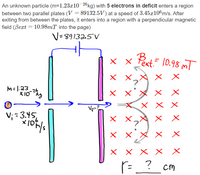
College Physics
11th Edition
ISBN: 9781305952300
Author: Raymond A. Serway, Chris Vuille
Publisher: Cengage Learning
expand_more
expand_more
format_list_bulleted
Concept explainers
Question

Transcribed Image Text:a) Calculate the speed (vf) that the particle will have when it exits from between
the parallel plates. (Write your answer in 3 significant digits)
b) Calculate the particle's radius of curvature (in cm) when it enters the region
with the perpendicular magnetic field. (Write your answer in 3 significant digits)
c) Will the particle travel Clockwise or Counterclockwise in the magnetic field?
Explain how you determined your answer

Transcribed Image Text:An unknown particle (m=1.23x10¯26kg) with 5 electrons in deficit enters a region
between two parallel plates (V =89132.5V) at a speed of 3.45x106m/s. After
exiting from between the plates, it enters into a region with a perpendicular magnetic
field (Bext = 10.98MT into the page)
|3D
V=89132.5 V
Pest- 10.98 mT
×っ ×
M= 1.23
X 10
Vp=?
X X
V; = 3.45,
X X X X
= ? _cm
%3D
X x X X X
X X X
X X X
Expert Solution
This question has been solved!
Explore an expertly crafted, step-by-step solution for a thorough understanding of key concepts.
Step by stepSolved in 4 steps

Knowledge Booster
Learn more about
Need a deep-dive on the concept behind this application? Look no further. Learn more about this topic, physics and related others by exploring similar questions and additional content below.Similar questions
- An electron and a proton are launched downwards with the same speed v into a magnetic field that is directed into the page. Describe and draw the different paths of the electron and the proton. Comment on the relative trajectories of the particles, and explain how the characteristics of the particles affect their paths.arrow_forwardneed help non graded practice from text bookarrow_forward5) A beta particle emitted by radioactive C-14 passes through a uniform magnetic field with magnitude 1.60 T. The beta particle is moving up along the screen with a speed equal to 86.3% of the speed of light c, and the uniform field points to the right. a) In what direction will the beta particle be deflected? Explain briefly how you got your b) answer. s What will be the magnitude of the magnetic force (in N) acting on the beta particle? Show your work. Without doing another calculation, what magnitude of magnetic force would an alpha particle, moving with the same speed as the beta particle, experience in this magnetic field? Explain your answer briefly.arrow_forward
- An electron enters a large solenoid at a 7.2" angle to the axis. Part A If the field is a uniform 3.7x10-2T, determine the radius of the electron's helical path if its speed is 2.0x107 m/s Express your answer using two significant figures. ? marrow_forwardPlease explain your answer.arrow_forward1. Figure 1 below shows an electron moving in +x direction enter uniform magnetic field directed into the plane. Draw the path taken by the electron as they pass through the magnetic field region and leave from side QR. If another electron enters the same region with higher velocity, what happen to the path travel by the electron? Sketch the electron motion on the same diagram and explain your answer. electron Figure 1arrow_forward
- Please answer 6-10 only.arrow_forwardplease explain step by steparrow_forwardUse: μ= 4T x 10-7 Hm-¹, electron charge = -1.6x10-1⁹ C Question A narrow beam of electrons was directed at a speed of 2.9 x 107 m s-1 into a uniform magnetic field. The beam followed a circular path of radius 35 mm. a) Calculate the flux density of the magnetic field (mass of an electron = 9.1 x 10-³1 kg) b) If the speed of the electrons in the beam was halved, what effect would this have on the radius of curvature of the beam in the field? Justify your answer.arrow_forward
arrow_back_ios
arrow_forward_ios
Recommended textbooks for you
 College PhysicsPhysicsISBN:9781305952300Author:Raymond A. Serway, Chris VuillePublisher:Cengage Learning
College PhysicsPhysicsISBN:9781305952300Author:Raymond A. Serway, Chris VuillePublisher:Cengage Learning University Physics (14th Edition)PhysicsISBN:9780133969290Author:Hugh D. Young, Roger A. FreedmanPublisher:PEARSON
University Physics (14th Edition)PhysicsISBN:9780133969290Author:Hugh D. Young, Roger A. FreedmanPublisher:PEARSON Introduction To Quantum MechanicsPhysicsISBN:9781107189638Author:Griffiths, David J., Schroeter, Darrell F.Publisher:Cambridge University Press
Introduction To Quantum MechanicsPhysicsISBN:9781107189638Author:Griffiths, David J., Schroeter, Darrell F.Publisher:Cambridge University Press Physics for Scientists and EngineersPhysicsISBN:9781337553278Author:Raymond A. Serway, John W. JewettPublisher:Cengage Learning
Physics for Scientists and EngineersPhysicsISBN:9781337553278Author:Raymond A. Serway, John W. JewettPublisher:Cengage Learning Lecture- Tutorials for Introductory AstronomyPhysicsISBN:9780321820464Author:Edward E. Prather, Tim P. Slater, Jeff P. Adams, Gina BrissendenPublisher:Addison-Wesley
Lecture- Tutorials for Introductory AstronomyPhysicsISBN:9780321820464Author:Edward E. Prather, Tim P. Slater, Jeff P. Adams, Gina BrissendenPublisher:Addison-Wesley College Physics: A Strategic Approach (4th Editio...PhysicsISBN:9780134609034Author:Randall D. Knight (Professor Emeritus), Brian Jones, Stuart FieldPublisher:PEARSON
College Physics: A Strategic Approach (4th Editio...PhysicsISBN:9780134609034Author:Randall D. Knight (Professor Emeritus), Brian Jones, Stuart FieldPublisher:PEARSON

College Physics
Physics
ISBN:9781305952300
Author:Raymond A. Serway, Chris Vuille
Publisher:Cengage Learning

University Physics (14th Edition)
Physics
ISBN:9780133969290
Author:Hugh D. Young, Roger A. Freedman
Publisher:PEARSON

Introduction To Quantum Mechanics
Physics
ISBN:9781107189638
Author:Griffiths, David J., Schroeter, Darrell F.
Publisher:Cambridge University Press

Physics for Scientists and Engineers
Physics
ISBN:9781337553278
Author:Raymond A. Serway, John W. Jewett
Publisher:Cengage Learning

Lecture- Tutorials for Introductory Astronomy
Physics
ISBN:9780321820464
Author:Edward E. Prather, Tim P. Slater, Jeff P. Adams, Gina Brissenden
Publisher:Addison-Wesley

College Physics: A Strategic Approach (4th Editio...
Physics
ISBN:9780134609034
Author:Randall D. Knight (Professor Emeritus), Brian Jones, Stuart Field
Publisher:PEARSON